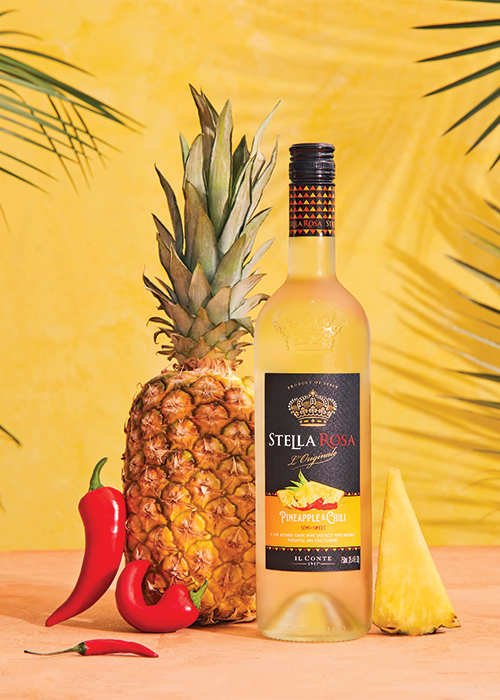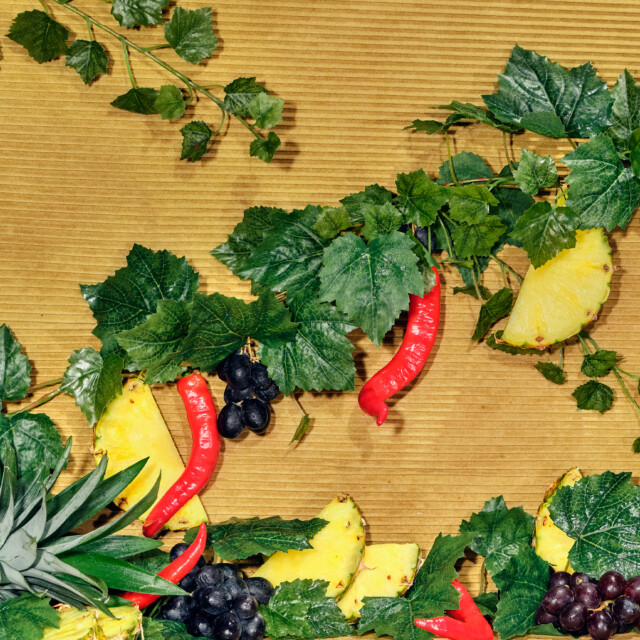The hottest new wine of 2023 turned up the heat on the wine industry: Stella Rosa Pineapple & Chili, the first of three new additions to the company’s Spicy Series. The low-alcohol (5 percent ABV) wine blends Moscato d’Asti grapes with tropical fruit natural flavors and a distillate of Calabrian chilis. According to Nielsen data, it was the best-selling new wine SKU of 2023.
So what’s behind the success of this surprising category winner? And what can the wine industry learn from the breakout sweet ’n’ spicy beverage?
Following the RTD Trend
The Riboli family founded the San Antonio Winery outside of Los Angeles in 1917. Today, the Riboli Family Wines portfolio covers 25 brands, including the popular Stella Rosa label, a line of semi-sweet, semi-sparkling Italian wines. According to Shanken News Daily, Stella Rosa averaged an annual growth rate of over 41 percent between 2015 and 2020, and with frequent launches of new products, it continues to expand.
The brand is also somewhat of an anomaly in an industry that’s struggling to not just retain drinkers but bring them into the fold: 27 percent of Stella Rosa’s sales in 2023 came from new drinkers entering the wine category for the first time, according to Stella’s Rosa’s own data.
Steve Riboli, CEO and president of Riboli Family Wines, says that when ideating on what would become the new Spicy Series line of wines, the company took its cues from what some in the wine industry might view as competition: cocktails. Noticing a trend toward sweet, spice, and salt in that space — and also in beer, as highlighted by the popularity of Micheladas — the company thought about how to deliver these flavors to Stella Rosa consumers. Pineapple & Chili came first, and the line grew to also include Mango & Chili and Lime & Chili.
Jon Moramarco, managing partner of data analysis firm BW 166, thinks the correlation makes sense. The only category to see growth in the beverage alcohol market from 2022 to 2023 was spirits-based ready-to-drink (RTD) cocktails, to the tune of 50.4 percent, according to the Gomberg, Fredrikson, and Associates data Moramarco works with. “I think part of what’s driving the RTD growth is more robust flavors,” Moramarco says. “The attraction of [Pineapple & Chili] is that it is something with more flavor.”
The Power of Marketing
But flavor profile is only part of the picture — smart marketing and positioning also helped Pineapple & Chili wine take off. Although called “wine,” the moniker doesn’t completely encapsulate the various ways to serve and consume the drink.
“People are looking to be courageous, experimental, and to try something new,” says Riboli. He estimates about two-thirds of consumers drink it like wine, or on the rocks, but the remaining third use Pineapple & Chili in cocktails. The website offers drink recipes for the different flavors, such as a Pineapple & Chili Margarita, which includes tequila, Cointreau, and lime juice — along with the wine – as its ingredients.
This crossover positioning smartly allows the product to work flexibly across alcoholic beverage categories and appeal to people who may not necessarily be wine drinkers.
“I think [products like Pineapple & Chili] can be considered potential on-ramps into the wine category over time.”
The brand also heavily leverages social media — that vast landscape where trends like putting jalapeños into rosé wine gain traction — to reach consumers. Riboli says a large social platform allows fans of the brand to share how they use the product and potentially inspire others. Traditional out-of-home media, such as billboards, ads, as well as in-store shelf talkers, and other displays round out the brand’s marketing strategy and reach a demographic that might not engage with TikTok and Instagram. “The label definitely pops on the shelf,” says David Spohr Sr., director of wine, beer and spirits merchandising at Albertsons Companies.
How We Eat Is How We Drink
According to the 2020 U.S. Census Bureau, the United States is more ethnically and racially diverse than it has ever been, and this carries over into the way we eat — and drink.
Danny Brager, a beverage alcohol industry consultant, says wine in general underperforms with Asian, Black, and Hispanic populations, but “Stella Rosa as a brand just does really well among demographic groups that generally are underdeveloped for wine overall.” His NiQ data also shows that Stella Rosa over-indexes with consumers aged 21 to 34. Riboli notes that many already have spicy foods as part of their culture and diet. “We’re not educating them to be a spice lover,” he says.
As our palates diversify, how we think about wine pairings also might evolve, and wine like Pineapple & Chili may offer some interesting alternatives. According to Mintel data, 75 percent of consumers enjoy spicy foods “to some degree,” and 59 percent of consumers ages 18 to 34 prefer “very spicy” levels of heat. In addition, two out of three Americans are interested in sweet and spicy flavors. “As a wine industry, we tend to keep talking about food and wine pairings with Eurocentric foods,” Moramarco says. “And as I look at diets today, especially for younger consumers, you see more Thai and Vietnamese and Latin [foods being consumed].” Spohr attributes the wine’s ability to pair well with spicy foods as part of its success in his stores.
An On-Ramp for Drinkers
One other important factor in the wine’s success is that there were fewer large-scale product launches in the last year — an aftershock of the pandemic. “Retailers are maybe just a bit more hesitant about new products,” Moramarco says. While the pandemic shifted the vast majority of purchases from on- to off-premise, the demand was for traditional wines — something comforting and familiar in a time of upheaval. With less competition this past year, it was easier for an outlier to stand out.

However, Moramarco is quick to point out that this shouldn’t diminish the success of the Spicy Series. Looking historically at wine trends, he thinks a beverage like Pineapple & Chili could be the key to capturing new consumers. “I actually believe wine coolers in the ’80s introduced the baby boomers to wine,” he says. “And table wines started taking off in 1993 when the average baby boomer was 37. So it’s not like 25-year-olds have ever been a key driver of the table wine business in the country. I think [products like Pineapple & Chili] can be considered potential on-ramps into the wine category over time.”
“Succeed fast and support, or fail fast and get back to the drawing board. It’s refreshing to see.”
“Let’s face it, we’ll never have a conversation about the ‘wild, new innovations’ coming out of Burgundy,” adds Brian Price, wine category manager for GoPuff/BevMo/Liquor Barn. Pineapple & Chili — and Stella Rosa wines in general — do well in Price’s Kentucky market. For the industry to attract a new age of drinkers, he applauds fast innovation and a willingness to test ideas, such as what Stella Rosa’s done with its ever-expanding offerings. “Succeed fast and support, or fail fast and get back to the drawing board. It’s refreshing to see,” Price says. And for consumers, when offered at an approachable price point ($10.99 suggested retail price), it makes trying something new feel less risky.
Thinking in the broader context of what’s happening in the wine industry, hybrids, co-ferments, and fruit wines are gaining prestige and popularity in certain segments of the market, especially among consumers interested in low-intervention and natural wines. Although these outside-of-the-box wines are still a nascent category, and their production differs in many ways from low-ABV, flavored wines, their popularity shows a thirst for non-traditional options with many demographics.
“We need folks to experiment with wine,” Riboli says. To him, the industry has traditionally made wine too austere and created too many barriers to enjoyment. At the end of the day, wine drinkers just want something easy and delicious. “The world is complicated,” he says. “People want to have fun.”
This story is a part of VP Pro, our free platform and newsletter for drinks industry professionals, covering wine, beer, liquor, and beyond. Sign up for VP Pro now!
